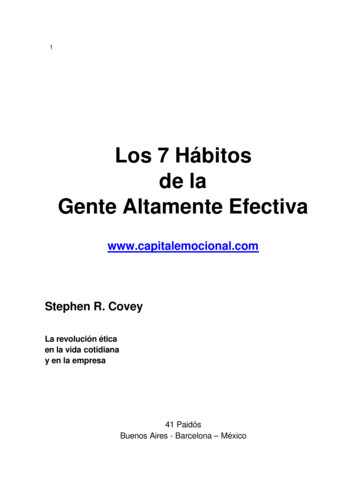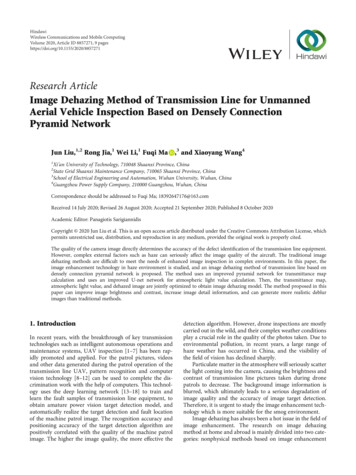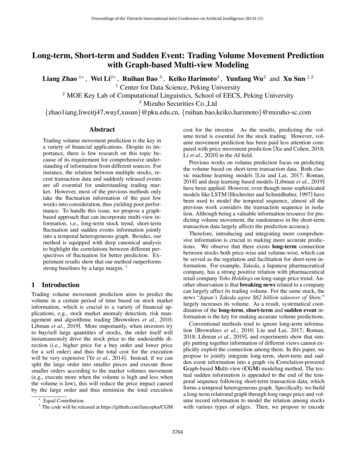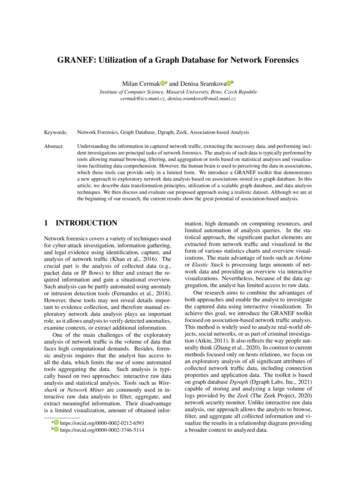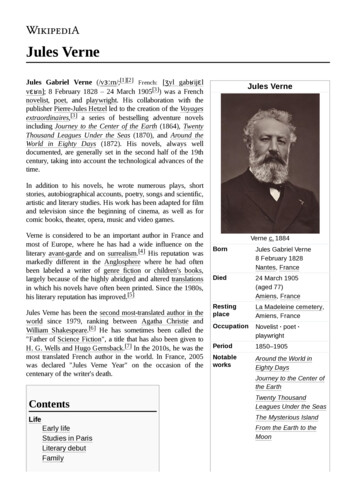
Transcription
Jules VerneJules Gabriel Verne (/vɜːrn/;[1][2] French: [ʒyl gabʁijɛlvɛʁn]; 8 February 1828 – 24 March 1905[3]) was a Frenchnovelist, poet, and playwright. His collaboration with thepublisher Pierre-Jules Hetzel led to the creation of the Voyagesextraordinaires,[3] a series of bestselling adventure novelsincluding Journey to the Center of the Earth (1864), TwentyThousand Leagues Under the Seas (1870), and Around theWorld in Eighty Days (1872). His novels, always welldocumented, are generally set in the second half of the 19thcentury, taking into account the technological advances of thetime.Jules VerneIn addition to his novels, he wrote numerous plays, shortstories, autobiographical accounts, poetry, songs and scientific,artistic and literary studies. His work has been adapted for filmand television since the beginning of cinema, as well as forcomic books, theater, opera, music and video games.Verne is considered to be an important author in France andmost of Europe, where he has had a wide influence on theliterary avant-garde and on surrealism.[4] His reputation wasmarkedly different in the Anglosphere where he had oftenbeen labeled a writer of genre fiction or children's books,largely because of the highly abridged and altered translationsin which his novels have often been printed. Since the 1980s,his literary reputation has improved.[5]Jules Verne has been the second most-translated author in theworld since 1979, ranking between Agatha Christie andWilliam Shakespeare.[6] He has sometimes been called the"Father of Science Fiction", a title that has also been given toH. G. Wells and Hugo Gernsback.[7] In the 2010s, he was themost translated French author in the world. In France, 2005was declared "Jules Verne Year" on the occasion of thecentenary of the writer's death.Verne c. 1884BornJules Gabriel Verne8 February 1828Nantes, FranceDied24 March 1905(aged 77)Amiens, FranceRestingplaceLa Madeleine cemetery,Amiens, FranceOccupationNovelist · poet ·playwrightPeriod1850–1905NotableworksAround the World inEighty DaysJourney to the Center ofthe EarthContentsTwenty ThousandLeagues Under the SeasLifeThe Mysterious IslandEarly lifeStudies in ParisLiterary debutFamilyFrom the Earth to theMoon
These five, and mostof Verne's novels,were published in theVoyagesextraordinaires series.HetzelLater yearsDeath and posthumous publicationsWorksLiterary receptionEnglish translationsRelationship with science fictionLegacyNotesFootnotesReferencesGeneral sourcesSpouseHonorine Anne Hébéedu Fraysne de Viane(m. 1857)Children1 son: Michel Verne2 step-daughters:Valentine MorelSuzanne MorelSignatureExternal linksOnline editionsLifeEarly lifeNantes from Île Feydeau, around thetime of Verne's birthVerne was born on 8 February 1828, on Île Feydeau, a smallartificial island on the river Loire within the town of Nantes, in No.4 Rue Olivier-de-Clisson, the house of his maternal grandmotherDame Sophie Marie Adélaïde Julienne Allotte de La Fuÿe (bornGuillochet de La Perrière).[8] His parents were Pierre Verne, anattorney originally from Provins, and Sophie Allotte de La Fuÿe, aNantes woman from a local family of navigators and shipowners,of distant Scottish descent.[9][a] In 1829, the Verne family movedsome hundred metres away to No. 2 Quai Jean-Bart, where Verne'sbrother Paul was born the same year. Three sisters, Anne "Anna"(1836), Mathilde (1839), and Marie (1842) would follow.[9]In 1834, at the age of six, Verne was sent to boarding school at 5 Place du Bouffay in Nantes. The teacher,Madame Sambin, was the widow of a naval captain who had disappeared some 30 years before.[10]Madame Sambin often told the students that her husband was a shipwrecked castaway and that he wouldeventually return like Robinson Crusoe from his desert island paradise.[11] The theme of the robinsonadewould stay with Verne throughout his life and appear in many of his novels, including The MysteriousIsland (1874), Second Fatherland (1900), and The School for Robinsons (1882).In 1836, Verne went on to École Saint‑Stanislas, a Catholic school suiting the pious religious tastes of hisfather. Verne quickly distinguished himself in mémoire (recitation from memory), geography, Greek, Latin,and singing.[12] In the same year, 1836, Pierre Verne bought a vacation house at 29 Rue des Réformés inthe village of Chantenay (now part of Nantes) on the Loire.[13] In his brief memoir Souvenirs d'enfance etde jeunesse (Memories of Childhood and Youth, 1890), Verne recalled a deep fascination with the river andwith the many merchant vessels navigating it.[14] He also took vacations at Brains, in the house of his unclePrudent Allotte, a retired shipowner, who had gone around the world and served as mayor of Brains from
1828 to 1837. Verne took joy in playing interminable rounds of the Game of the Goose with his uncle, andboth the game and his uncle's name would be memorialized in two late novels (The Will of an Eccentric(1900) and Robur the Conqueror (1886), respectively).[14][15]Legend has it that in 1839, at the age of 11, Verne secretly procured a spot as cabin boy on the three-mastship Coralie with the intention of traveling to the Indies and bringing back a coral necklace for his cousinCaroline. The evening the ship set out for the Indies, it stopped first at Paimboeuf where Pierre Vernearrived just in time to catch his son and make him promise to travel "only in his imagination".[16] It is nowknown that the legend is an exaggerated tale invented by Verne's first biographer, his niece MargueriteAllotte de la Füye, though it may have been inspired by a real incident.[17]In 1840, the Vernes moved again to a large apartment at No. 6 RueJean-Jacques-Rousseau, where the family's youngest child, Marie,was born in 1842.[13] In the same year Verne entered anotherreligious school, the Petit Séminaire de Saint-Donatien, as a laystudent. His unfinished novel Un prêtre en 1839 (A Priest in 1839),written in his teens and the earliest of his prose works tosurvive,[18] describes the seminary in disparaging terms.[12] From1844 to 1846, Verne and his brother were enrolled in the LycéeRoyal (now the Lycée Georges-Clemenceau) in Nantes. Afterfinishing classes in rhetoric and philosophy, he took thebaccalauréat at Rennes and received the grade "Good Enough" on29 July 1846.[19]The Lycée Royal in Nantes (now theLycée Georges-Clemenceau), whereJules Verne studiedBy 1847, when Verne was 19, he had taken seriously to writinglong works in the style of Victor Hugo, beginning Un prêtre en 1839 and seeing two verse tragedies,Alexandre VI and La Conspiration des poudres (The Gunpowder Plot), to completion.[18] However, hisfather took it for granted that Verne, being the firstborn son of the family, would not attempt to make moneyin literature but would instead inherit the family law practice.[20]In 1847, Verne's father sent him to Paris, primarily to begin his studies in law school, and secondarily(according to family legend) to distance him temporarily from Nantes.[21][22] His cousin Caroline, withwhom he was in love, was married on 27 April 1847, to Émile Dezaunay, a man of 40, with whom shewould have five children.[23]After a short stay in Paris, where he passed first-year law exams, Verne returned to Nantes for his father'shelp in preparing for the second year. (Provincial law students were in that era required to go to Paris totake exams.)[24] While in Nantes, he met Rose Herminie Arnaud Grossetière, a young woman one year hissenior, and fell intensely in love with her. He wrote and dedicated some thirty poems to her, including LaFille de l'air (The Daughter of Air), which describes her as "blonde and enchanting / winged andtransparent".[25] His passion seems to have been reciprocated, at least for a short time,[22] but Grossetière'sparents frowned upon the idea of their daughter marrying a young student of uncertain future. They marriedher instead to Armand Terrien de la Haye, a rich landowner ten years her senior, on 19 July 1848.[26]The sudden marriage sent Verne into deep frustration. He wrote a hallucinatory letter to his mother,apparently composed in a state of half-drunkenness, in which under pretext of a dream he described hismisery.[27] This requited but aborted love affair seems to have permanently marked the author and hiswork, and his novels include a significant number of young women married against their will (Gérande inMaster Zacharius (1854), Sava in Mathias Sandorf (1885), Ellen in A Floating City (1871), etc.), to suchan extent that the scholar Christian Chelebourg attributed the recurring theme to a "Herminie complex".[28]The incident also led Verne to bear a grudge against his birthplace and Nantes society, which he criticizedin his poem La sixième ville de France (The Sixth City of France).[29][30]
Studies in ParisIn July 1848, Verne left Nantes again for Paris, where his father intended him to finish law studies and takeup law as a profession. He obtained permission from his father to rent a furnished apartment at 24 Rue del'Ancienne-Comédie, which he shared with Édouard Bonamy, another student of Nantes origin.[27] (On his1847 Paris visit, Verne had stayed at 2 Rue Thérèse, the house of his aunt Charuel, on the Butte SaintRoch.)[31]Verne arrived in Paris during a time of political upheaval: the French Revolution of 1848. In February,Louis Philippe I had been overthrown and had fled; on 24 February, a provisional government of theFrench Second Republic took power, but political demonstrations continued, and social tension remained.In June, barricades went up in Paris, and the government sent Louis-Eugène Cavaignac to crush theinsurrection. Verne entered the city shortly before the election of Louis-Napoléon Bonaparte as the firstpresident of the Republic, a state of affairs that would last until the French coup of 1851. In a letter to hisfamily, Verne described the bombarded state of the city after the recent June Days uprising but assured themthat the anniversary of Bastille Day had gone by without any significant conflict.[32]Verne used his family connections to make an entrance into Paris society.His uncle Francisque de Chatêaubourg introduced him into literary salons,and Verne particularly frequented those of Mme de Barrère, a friend of hismother's.[33] While continuing his law studies, he fed his passion for thetheater, writing numerous plays. Verne later recalled: "I was greatly underthe influence of Victor Hugo, indeed, very excited by reading and rereading his works. At that time I could have recited by heart whole pagesof Notre Dame de Paris, but it was his dramatic work that most influencedme."[34] Another source of creative stimulation came from a neighbor:living on the same floor in the Rue de l'Ancienne-Comédie apartmenthouse was a young composer, Aristide Hignard, with whom Verne soonbecame good friends, and Verne wrote several texts for Hignard to set aschansons.[35]During this period, Verne's letters to his parents primarily focused onAristide Hignardexpenses and on a suddenly appearing series of violent stomach cramps,[36]the first of many he would suffer from during his life. (Modern scholarshave hypothesized that he suffered from colitis;[36] Verne believed the illness to have been inherited fromhis mother's side.[37]) Rumors of an outbreak of cholera in March 1849 exacerbated these medicalconcerns.[36] Yet another health problem would strike in 1851 when Verne suffered the first of four attacksof facial paralysis. These attacks, rather than being psychosomatic, were due to an inflammation in themiddle ear, though this cause remained unknown to Verne during his life.[38]In the same year, Verne was required to enlist in the French military, but the sortition process spared him, tohis great relief. He wrote to his father: "You should already know, dear papa, what I think of the militarylife, and of these domestic servants in livery. You have to abandon all dignity to perform suchfunctions."[39] Verne's strong antiwar sentiments, to the dismay of his father, would remain steadfastthroughout his life.[39]Though writing profusely and frequenting the salons, Verne diligently pursued his law studies andgraduated with a licence en droit in January 1851.[40]Literary debut
Thanks to his visits to salons, Verne came into contact in 1849 with Alexandre Dumas through the mutualacquaintance of a celebrated chirologist of the time, the Chevalier d'Arpentigny.[40] Verne became closefriends with Dumas' son, Alexandre Dumas fils, and showed him a manuscript for a stage comedy, LesPailles rompues (The Broken Straws). The two young men revised the play together, and Dumas, througharrangements with his father, had it produced by the Opéra-National at the Théâtre Historique in Paris,opening on 12 June 1850.[41]In 1851, Verne met with a fellow writer from Nantes, Pierre-MichelFrançois Chevalier (known as "Pitre-Chevalier"), the editor-in-chief of themagazine Musée des familles (The Family Museum).[42] Pitre-Chevalierwas looking for articles about geography, history, science, and technology,and was keen to make sure that the educational component would be madeaccessible to large popular audiences using a straightforward prose style oran engaging fictional story. Verne, with his delight in diligent research,especially in geography, was a natural for the job.[43] Verne first offeredhim a short historical adventure story, The First Ships of the Mexican Navy,written in the style of James Fenimore Cooper, whose novels had deeplyinfluenced him.[42] Pitre-Chevalier published it in July 1851, and in thesame year published a second short story by Verne, A Voyage in a Balloon(August 1851). The latter story, with its combination of adventurousnarrative, travel themes, and detailed historical research, would later bedescribed by Verne as "the first indication of the line of novel that I wasdestined to follow".[34]Cover of an 1854–55 issueof Musée des famillesDumas fils put Verne in contact with Jules Seveste, a stage director whohad taken over the directorship of the Théâtre Historique and renamed it theThéâtre Lyrique. Seveste offered Verne the job of secretary of the theater, with little or no salary attached.[9]Verne accepted, using the opportunity to write and produce several comic operas written in collaborationwith Hignard and the prolific librettist Michel Carré.[44] To celebrate his employment at the ThéâtreLyrique, Verne joined with ten friends to found a bachelors' dining club, the Onze-sans-femme (ElevenBachelors).[45]For some time, Verne's father pressed him to abandon his writing and begin a business as a lawyer.However, Verne argued in his letters that he could only find success in literature.[46] The pressure to planfor a secure future in law reached its climax in January 1852, when his father offered Verne his own Nanteslaw practice.[47] Faced with this ultimatum, Verne decided conclusively to continue his literary life andrefuse the job, writing: "Am I not right to follow my own instincts? It's because I know who I am that Irealize what I can be one day."[48]Meanwhile, Verne was spending much time at the Bibliothèque nationale de France, conducting researchfor his stories and feeding his passion for science and recent discoveries, especially in geography. It was inthis period that Verne met the illustrious geographer and explorer Jacques Arago, who continued to travelextensively despite his blindness (he had lost his sight completely in 1837). The two men became goodfriends, and Arago's innovative and witty accounts of his travels led Verne toward a newly developinggenre of literature: that of travel writing.[49][50]In 1852, two new pieces from Verne appeared in the Musée des familles: Martin Paz, a novella set in Lima,which Verne wrote in 1851 and published 10 July through 11 August 1852, and Les Châteaux enCalifornie, ou, Pierre qui roule n'amasse pas mousse (The Castles in California, or, A Rolling StoneGathers No Moss), a one-act comedy full of racy double entendres.[51] In April and May 1854, themagazine published Verne's short story Master Zacharius, an E. T. A. Hoffmann-like fantasy featuring asharp condemnation of scientific hubris and ambition,[52] followed soon afterward by A Winter Amid the
Ice, a polar adventure story whose themes closely anticipated many ofVerne's novels.[53] The Musée also published some nonfiction popularscience articles which, though unsigned, are generally attributed toVerne.[43] Verne's work for the magazine was cut short in 1856 when hehad a serious quarrel with Pitre-Chevalier and refused to continuecontributing (a refusal he would maintain until 1863, when Pitre-Chevalierdied, and the magazine went to new editorship).[54]While writing stories and articles for Pitre-Chevalier, Verne began to formthe idea of inventing a new kind of novel, a "Roman de la Science" ("novelof science"), which would allow him to incorporate large amounts of thefactual information he so enjoyed researching in the Bibliothèque. He isJacques Aragosaid to have discussed the project with the elder Alexandre Dumas, whohad tried something similar with an unfinished novel, Isaac Laquedem, andwho enthusiastically encouraged Verne's project.[55]At the end of 1854, another outbreak of cholera led to the death of Jules Seveste, Verne's employer at theThéâtre Lyrique and by then a good friend.[53] Though his contract only held him to a further year ofservice, Verne remained connected to the theater for several years after Seveste's death, seeing additionalproductions to fruition.[56] He also continued to write plays and musical comedies, most of which were notperformed.[54]FamilyIn May 1856, Verne traveled to Amiens to be the best man at the wedding of a Nantes friend, AugusteLelarge, to an Amiens woman named Aimée du Fraysne de Viane. Verne, invited to stay with the bride'sfamily, took to them warmly, befriending the entire household and finding himself increasingly attracted tothe bride's sister, Honorine Anne Hébée Morel (née du Fraysne de Viane), a widow aged 26 with twoyoung children.[57][58] Hoping to find a secure source of income, as well as a chance to court Morel inearnest, he jumped at her brother's offer to go into business with a broker.[59] Verne's father was initiallydubious but gave in to his son's requests for approval in November 1856. With his financial situation finallylooking promising, Verne won the favor of Morel and her family, and the couple were married on 10January 1857.[60]Verne plunged into his new business obligations, leaving his work at theThéâtre Lyrique and taking up a full-time job as an agent de change[54] onthe Paris Bourse, where he became the associate of the broker FernandEggly.[61] Verne woke up early each morning so that he would have timeto write, before going to the Bourse for the day's work; in the rest of hisspare time, he continued to consort with the Onze-Sans-Femme club (alleleven of its "bachelors" had by this time gotten married). He alsocontinued to frequent the Bibliothèque to do scientific and historicalresearch, much of which he copied onto notecards for future use—a systemhe would continue for the rest of his life.[54] According to the recollectionsof a colleague, Verne "did better in repartee than in business".[61]Jules Vernes Museum,Butte Saint-Anne, Nantes,FranceIn July 1858, Verne and Aristide Hignard seized an opportunity offered by Hignard's brother: a sea voyage,at no charge, from Bordeaux to Liverpool and Scotland. The journey, Verne's first trip outside France,deeply impressed him, and upon his return to Paris he fictionalized his recollections to form the backboneof a semi-autobiographical novel, Backwards to Britain (written in the autumn and winter of 1859–1860and not published until 1989).[62] A second complimentary voyage in 1861 took Hignard and Verne to
Stockholm, from where they traveled to Christiania and through Telemark.[63] Verne left Hignard inDenmark to return in haste to Paris, but missed the birth on 3 August 1861 of his only biological son,Michel.[64]Meanwhile, Verne continued work on the idea of a "Roman de la Science", which he developed in a roughdraft, inspired, according to his recollections, by his "love for maps and the great explorers of the world". Ittook shape as a story of travel across Africa and would eventually become his first published novel, FiveWeeks in a Balloon.[54]HetzelIn 1862, through their mutual acquaintance Alfred de Bréhat, Verne cameinto contact with the publisher Pierre-Jules Hetzel, and submitted to him themanuscript of his developing novel, then called Voyage en Ballon.[65]Hetzel, already the publisher of Honoré de Balzac, George Sand, VictorHugo, and other well-known authors, had long been planning to launch ahigh-quality family magazine in which entertaining fiction would combinewith scientific education.[66] He saw Verne, with his demonstratedinclination toward scrupulously researched adventure stories, as an idealcontributor for such a magazine, and accepted the novel, giving Vernesuggestions for improvement. Verne made the proposed revisions withintwo weeks and returned to Hetzel with the final draft, now titled FiveWeeks in a Balloon.[67] It was published by Hetzel on 31 January 1863.[68]To secure his services for the planned magazine, to be called the MagasinPierre-Jules Hetzeld'Éducation et de Récréation (Magazine of Education and Recreation),Hetzel also drew up a long-term contract in which Verne would give himthree volumes of text per year, each of which Hetzel would buy outright fora flat fee. Verne, finding both a steady salary and a sure outlet for writing at last, accepted immediately.[69]For the rest of his lifetime, most of his novels would be serialized in Hetzel's Magasin before theirappearance in book form, beginning with his second novel for Hetzel, The Adventures of Captain Hatteras(1864–65).[68]When The Adventures of Captain Hatteras was published in book form in 1866, Hetzel publiclyannounced his literary and educational ambitions for Verne's novels by saying in a preface that Verne'sworks would form a novel sequence called the Voyages extraordinaires (Extraordinary Voyages orExtraordinary Journeys), and that Verne's aim was "to outline all the geographical, geological, physical,and astronomical knowledge amassed by modern science and to recount, in an entertaining and picturesqueformat that is his own, the history of the universe".[70] Late in life, Verne confirmed that this commissionhad become the running theme of his novels: "My object has been to depict the earth, and not the earthalone, but the universe And I have tried at the same time to realize a very high ideal of beauty of style. Itis said that there can't be any style in a novel of adventure, but it isn't true."[71] However, he also noted thatthe project was extremely ambitious: "Yes! But the Earth is very large, and life is very short! In order toleave a completed work behind, one would need to live to be at least 100 years old!"[72]Hetzel influenced many of Verne's novels directly, especially in the first few years of their collaboration, forVerne was initially so happy to find a publisher that he agreed to almost all of the changes Hetzelsuggested. For example, when Hetzel disapproved of the original climax of Captain Hatteras, including thedeath of the title character, Verne wrote an entirely new conclusion in which Hatteras survived.[73] Hetzelalso rejected Verne's next submission, Paris in the Twentieth Century, believing its pessimistic view of the
future and its condemnation of technological progress were too subversivefor a family magazine.[74] (The manuscript, believed lost for some timeafter Verne's death, was finally published in 1994.)[75]A Hetzel edition of Verne'sThe Adventures of CaptainHatteras (cover style "Auxdeux éléphants")The relationship between publisher and writer changed significantly around1869 when Verne and Hetzel were brought into conflict over themanuscript for Twenty Thousand Leagues Under the Seas. Verne hadinitially conceived of the submariner Captain Nemo as a Polish scientistwhose acts of vengeance were directed against the Russians who had killedhis family during the January Uprising. Hetzel, not wanting to alienate thelucrative Russian market for Verne's books, demanded that Nemo be madean enemy of the slave trade, a situation that would make him anunambiguous hero. Verne, after fighting vehemently against the change,finally invented a compromise in which Nemo's past is left mysterious.After this disagreement, Verne became notably cooler in his dealings withHetzel, taking suggestions into consideration but often rejecting themoutright.[76]From that point, Verne published two or more volumes a year. The mostsuccessful of these are: Voyage au centre de la Terre (Journey to the Centerof the Earth, 1864); De la Terre à la Lune (From the Earth to the Moon, 1865); Vingt mille lieues sous lesmers (Twenty Thousand Leagues Under the Seas, 1869); and Le tour du monde en quatre-vingts jours(Around the World in Eighty Days), which first appeared in Le Temps in 1872. Verne could now live on hiswritings, but most of his wealth came from the stage adaptations of Le tour du monde en quatre-vingtsjours (1874) and Michel Strogoff (1876), which he wrote with Adolphe d'Ennery.[77]In 1867, Verne bought a small boat, the Saint-Michel, which hesuccessively replaced with the Saint-Michel II and the Saint-MichelIII as his financial situation improved. On board the Saint-MichelIII, he sailed around Europe. After his first novel, most of hisstories were first serialised in the Magazine d'Éducation et deRécréation, a Hetzel biweekly publication, before being publishedin book form. His brother Paul contributed to 40th French climbingof the Mont-Blanc and a collection of short stories – Doctor Ox – in1874. Verne became wealthy and famous.[78]Meanwhile, Michel Verne married an actress against his father'swishes, had two children by an underage mistress and buriedhimself in debts.[79] The relationship between father and sonimproved as Michel grew older.[80]Sketch by Verne of the Saint-MichelLater yearsThough raised as a Roman Catholic, Verne gravitated towards deism.[81][82] Some scholars believe hisnovels reflect a deist philosophy, as they often involve the notion of God or divine providence but rarelymention the concept of Christ.[83][84]On 9 March 1886, as Verne returned home, his twenty-six-year-old nephew, Gaston, shot at him twice witha pistol. The first bullet missed, but the second one entered Verne's left leg, giving him a permanent limpthat could not be overcome. This incident was hushed up in the media, but Gaston spent the rest of his lifein a mental asylum.[85]
After the deaths of both his mother and Hetzel (who died in 1886), JulesVerne began publishing darker works. In 1888 he entered politics and waselected town councillor of Amiens, where he championed severalimprovements and served for fifteen years.[86]Verne was made a Chevalier de la Légion d'honneur in 1870. He waspromoted to an Officier de la Légion d'honneur in 1892.Jules Verne and MadameVerne c. 1900Death and posthumous publicationsOn 24 March 1905, while ill with chronic diabetes and complications from a stroke which paralyzed hisright side, Verne died at his home in Amiens,[87] 44 Boulevard Longueville (now Boulevard Jules-Verne).His son, Michel Verne, oversaw the publication of the novels Invasion of the Sea and The Lighthouse at theEnd of the World after Jules's death. The Voyages extraordinaires series continued for several yearsafterwards at the same rate of two volumes a year. It was later discovered that Michel Verne had madeextensive changes in these stories,[3] and the original versions were eventually published at the end of the20th century by the Jules Verne Society (Société Jules Verne). In 1919, Michel Verne published The BarsacMission (French: L'Étonnante Aventure de la Mission Barsac), whose original drafts contained references toEsperanto,[88] a language that his father had been very interested in.[89][90]In 1989, Verne's great-grandson discovered his ancestor's as-yet-unpublished novel Paris in the TwentiethCentury, which was subsequently published in 1994.[91]Jules Verne on his deathbedVerne's funeral procession, headedby his son and grandson
Verne's tomb inAmiensWorksVerne's largest body of work is the Voyages extraordinaires series, whichincludes all of his novels except for the two rejected manuscripts Paris inthe Twentieth Century and Backwards to Britain (published posthumouslyin 1994 and 1989, respectively) and for projects left unfinished at his death(many of which would be posthumously adapted or rewritten forpublication by his son Michel).[92] Verne also wrote many plays, poems,song texts, operetta libretti, and short stories, as well as a variety of essaysand miscellaneous non-fiction.Literary receptionAfter his debut under Hetzel, Verne was enthusiastically received in Franceby writers and scientists alike, with George Sand and Théophile Gautieramong his earliest admirers.[93] Several notable contemporary figures, fromthe geographer Vivien de Saint-Martin to the critic Jules Claretie,spoke highly of Verne and his works in critical and biographicalnotes.[94]An 1889 Hetzel posteradvertising Verne's worksHowever, Verne's growing popularity among readers and playgoers(due especially to the highly successful stage version of Around theWorld in Eighty Days) led to a gradual change in his literaryreputation. As the novels and stage productions continued to sell,many contemporary critics felt that Verne's status as a commerciallypopular author meant he could only be seen as a mere genre-basedstoryteller, rather than a serious author worthy of academicstudy.[95]This denial of formal literary status took various forms, includingdismissive criticism by such writers as Émile Zola and the lack ofVerne's nomination for membership in the Académie Française,
Island (1874), Second F atherland (1900), and T he School for R obinsons (1882). In 1836, Verne w ent on to É cole S aint‑S tanislas, a C atholic school suiting the pious religious tastes of his father. Verne quickly distinguished himself in m ém oire (recitation from memory), geography, G reek, L atin, and singing.


